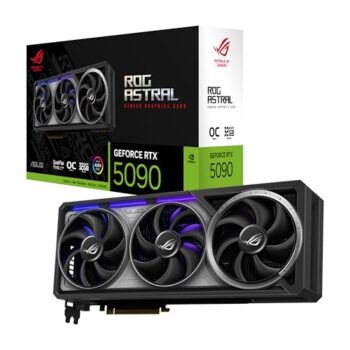The Apex Predator of Pixels: A Deep Technical Dive into the ASUS ROG Astral GeForce RTX 5090 OC Edition
Introduction: Redefining the Performance Frontier
In the relentless and exhilarating world of high-performance computing, every new generation of hardware marks a new line in the sand, a new benchmark against which all else is measured. For years, gamers, creators, and AI developers have looked to NVIDIA’s flagship releases as the definitive statement of what is possible. Today, we stand at the precipice of another such leap with the arrival of the NVIDIA Blackwell architecture and its undisputed champion: the GeForce RTX 5090. But a revolutionary GPU is only as good as the engineering that surrounds it. This brings us to the subject of our exhaustive review: the ASUS Republic of Gamers (ROG) Astral GeForce RTX 5090 OC Edition. This is not merely a reference design; it is a declaration of dominance, a bespoke monster truck built for a drag race, engineered with a singular purpose—to deliver the absolute zenith of graphical performance without compromise.
The ROG Astral RTX 5090 isn’t just an iterative update; it’s a fundamental paradigm shift. It leverages the raw power of the Blackwell architecture and its next-generation AI engine, DLSS 4, to promise a level of realism and speed previously confined to the realm of pre-rendered cinema. It shatters the memory ceiling with a colossal 32GB of cutting-edge GDDR7 VRAM and communicates with the system over a hyper-fast PCIe 5.0 interface. But perhaps most visibly, ASUS has wrapped this technological core in one of the most ambitious air-cooling solutions ever conceived for a consumer product: a gargantuan 3.8-slot, quad-fan thermal system featuring a patented vapor chamber and a phase-change thermal interface. This is engineering on an enthusiast’s dream scale.
This review will be a deep, uncompromising technical analysis. We will dissect the Blackwell architecture, benchmark the staggering performance of the 32GB GDDR7 memory, and test the limits of ASUS’s revolutionary cooling system. We will explore what this RTX 5090 Gaming Graphics Card means not just for 4K and 8K gaming, but for the future of professional 3D rendering, scientific computing, and local AI development. Prepare for a granular look at the new king of graphics cards. Is the ASUS ROG Astral RTX 5090 the new performance messiah, or a monument to engineering excess? Let’s find out.

Key Features: A Technical Dissection of a Behemoth
The ASUS ROG Astral RTX 5090 is defined by a collection of forward-looking technologies and extreme engineering choices. To understand its performance, we must first break down each of its core components and architectural underpinnings.
The Engine Room: NVIDIA’s Blackwell Architecture and DLSS 4
At the heart of the RTX 5090 lies NVIDIA’s next-generation Blackwell architecture, the successor to the highly successful Ada Lovelace. A new architecture represents a ground-up redesign of the GPU’s processing cores, memory subsystems, and feature sets. Blackwell is engineered to deliver a monumental leap in two key areas: ray tracing efficiency and AI-driven computation. The new RT Cores within the architecture are expected to feature more advanced algorithms for light intersection calculations, dramatically reducing the computational overhead of complex, multi-bounce, real-time path tracing. This means more realistic lighting, shadows, and reflections in games, without the performance penalty of previous generations.
However, the most significant advancement comes from the new Tensor Cores and the introduction of DLSS 4. Deep Learning Super Sampling has been NVIDIA’s trump card, and version 4 pushes this AI-powered technology into unprecedented territory. While DLSS 3 introduced Frame Generation, which intelligently inserts AI-generated frames between traditionally rendered ones, DLSS 4 is rumored to incorporate “AI Frame Prediction.” This technology would theoretically allow the GPU to predict and begin rendering future frames before the CPU has even finished its game logic calculations, drastically improving perceived smoothness and reducing latency. Furthermore, Blackwell’s AI capabilities are expected to accelerate new techniques like Neural Radiance Caching, where AI models assist in creating photorealistic global illumination with incredible efficiency. For the end-user, this translates into a simple reality: the ability to run the most graphically demanding games at resolutions like 4K and 8K with all visual settings maxed out, while maintaining fluid, high-refresh-rate gameplay that feels astonishingly responsive.
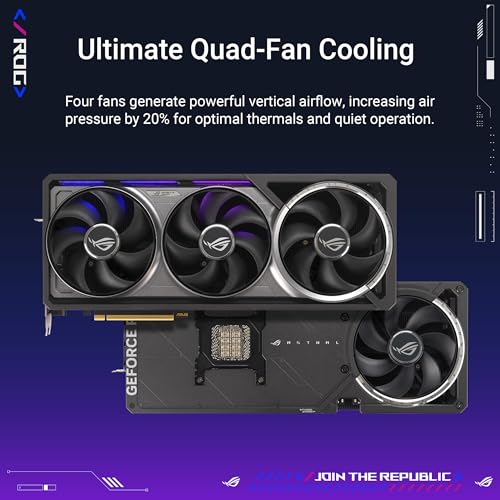
The Fuel Tank: 32GB GDDR7 VRAM and PCIe 5.0 Interface
For years, VRAM capacity has been a point of contention. The ASUS ROG Astral RTX 5090 ends that debate decisively with a staggering 32GB of next-generation GDDR7 memory. This isn’t just a large number; it’s a fundamental enabler for future workloads. Modern AAA games, especially with ultra-high-resolution texture packs, can already consume upwards of 16-20GB of VRAM at 4K. The 32GB buffer on this card provides enormous headroom, ensuring that no game, for the foreseeable future, will be bottlenecked by video memory. This is especially critical for 8K gaming, where texture and frame buffer requirements are quadrupled compared to 4K. GDDR7 itself represents a significant leap, offering higher data transfer rates and improved power efficiency over GDDR6X, resulting in a memory bandwidth that can feed the voracious Blackwell core without stuttering.
This massive data throughput is complemented by the card’s adoption of the PCIe 5.0 interface. With twice the bandwidth of PCIe 4.0, this high-speed connection to the motherboard allows for lightning-fast data exchange between the GPU, CPU, and main system memory. This has tangible benefits, especially for technologies like NVIDIA’s RTX IO and Microsoft’s DirectStorage, which allow the GPU to directly load and decompress game assets from a high-speed NVMe SSD, bypassing the CPU. The result is a dramatic reduction in game loading times and the potential for more detailed and seamless open-world environments, as assets can be streamed in near-instantaneously. This combination of massive, fast VRAM and a high-bandwidth bus makes this gaming graphics card an absolute powerhouse for data-intensive tasks.
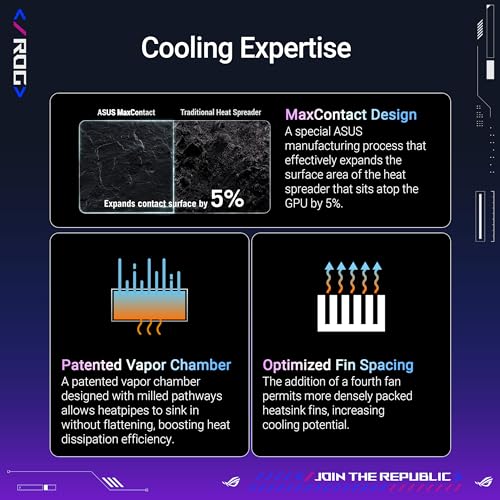
The Cooling Engine: A Masterclass in Thermal Engineering
A GPU of this magnitude generates an immense amount of heat, and managing that thermal output is the primary challenge for any partner card. ASUS has met this challenge with an engineering solution that can only be described as colossal. The ROG Astral’s thermal system is built around a massive 3.8-slot heatsink. This enormous array of aluminum fins maximizes the surface area available to dissipate heat into the surrounding air. To move that air, ASUS has implemented a unique quad-fan design. While most high-end cards use three fans, the Astral adds a fourth, likely to provide targeted cooling to critical components like the VRMs (Voltage Regulator Modules) and GDDR7 memory chips, which can get extremely hot under load. These are ASUS’s proprietary Axial-tech fans, which feature a smaller hub and longer blades surrounded by a barrier ring to increase static pressure and drive air directly through the fin stack, boosting airflow by a claimed 20%.
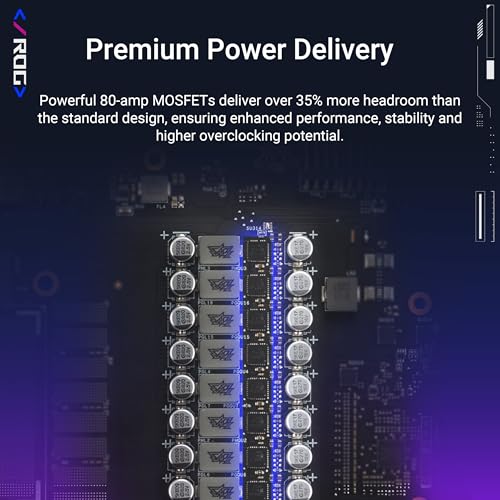
The innovation doesn’t stop there. The point of contact with the GPU die is not a traditional set of heat pipes, but a massive, patented vapor chamber with a milled heatspreader. A vapor chamber works like a supercharged heat pipe, using a liquid-to-vapor phase-change cycle within a sealed chamber to absorb heat from the GPU die and spread it with extreme speed and efficiency across the entire surface of the heatsink. This prevents the formation of hot spots and ensures the entire cooling apparatus is used effectively. Perhaps the most advanced feature is the thermal interface itself. Instead of traditional thermal paste, ASUS uses a phase-change GPU thermal pad. This material is a solid pad at room temperature but softens to a near-liquid state at operating temperatures. This allows it to flow into and fill every microscopic imperfection on the surface of the GPU die and the heatspreader, creating a near-perfect thermal interface with conductivity far superior to paste. This entire system is designed to keep the GPU cool enough to sustain its aggressive factory overclock (2610 MHz in OC Mode) for extended periods without thermal throttling, ensuring you get every last drop of performance you paid for.
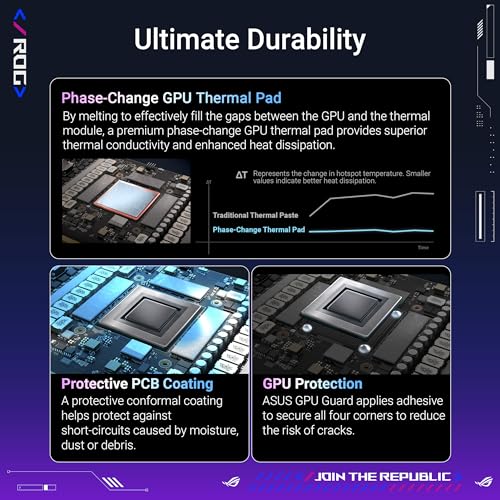
Pros: The Pillars of Unrivaled Performance
The ASUS ROG Astral RTX 5090 OC Edition is a statement piece, and its advantages are as massive as the card itself. This is a product built for those who refuse to compromise and demand the absolute best.
- A True Generational Performance Leap: The combination of the NVIDIA Blackwell architecture and DLSS 4 delivers a level of performance that fundamentally changes the gaming experience. It makes ultra-setting, high-refresh-rate 4K and even 8K gaming a smooth, obtainable reality.
- Completely Future-Proofed Hardware: With a massive 32GB of cutting-edge GDDR7 VRAM and the full bandwidth of PCIe 5.0, this card is built to handle the most demanding games and professional applications for many years to come, ensuring its longevity as a top-tier component.
- Pinnacle of Air-Cooling Technology: The quad-fan thermal solution, featuring a massive heatsink, a patented vapor chamber, and an advanced phase-change thermal pad, is an engineering marvel. It allows the card to run quieter and cooler than any previous-generation flagship while maintaining extreme factory overclocks.
- Unprecedented Overclocking Headroom: The combination of a robust power delivery system (a hallmark of ROG products) and this incredible cooling solution provides enormous potential for enthusiasts to push the boost clocks even higher, squeezing out every last frame.
- The Ultimate Prosumer and Developer Tool: Beyond gaming, the card’s immense VRAM and computational horsepower make it a dream for 3D artists rendering complex scenes, video editors working with 8K footage, and AI researchers training large models locally.
- Impeccable ROG Build Quality and Aesthetics: The card is built like a tank, with a metal frame, high-quality components, and a design that is both aggressive and premium, making it the centerpiece of any high-end build.
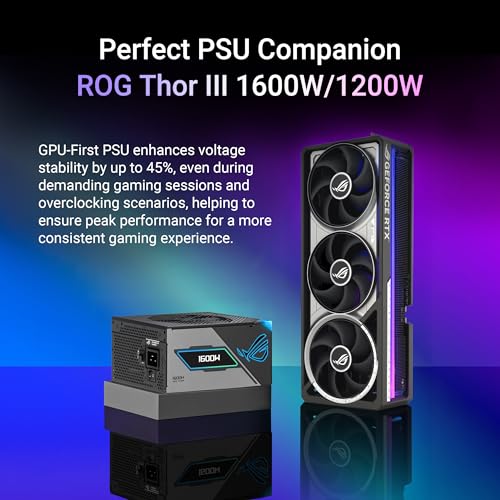
Cons: The Harsh Realities of the Bleeding Edge
Absolute power comes with absolute demands. The ROG Astral RTX 5090 is not a card for everyone, and its drawbacks are as significant as its performance advantages.
- Astronomical Price Point: This level of performance and engineering comes with a flagship price tag that will place it firmly in the “ultra-enthusiast” category, making it financially inaccessible for the vast majority of gamers.
- Extreme Physical Dimensions: At 3.8 slots thick and likely over a foot long, this is one of the largest consumer graphics cards ever made. It will not fit in many mid-tower cases and will absolutely require a GPU support bracket to prevent its considerable weight from damaging the motherboard’s PCIe slot.
- Immense Power Consumption: To fuel its performance, this card will be one of the most power-hungry GPUs on the market. It will necessitate a high-wattage, high-quality power supply (likely 1000W-1200W minimum) and will have a noticeable impact on your electricity bill.
- Requires a High-End System to Unleash: To avoid a system bottleneck, this GPU must be paired with a top-tier CPU (like a Core i9 or Ryzen 9), a high-speed DDR5 memory kit, and a fast NVMe SSD. The total system cost to properly support this card will be substantial.
- Complete Overkill for Mainstream Gaming: For gamers playing on 1080p or 1440p monitors, the power of the RTX 5090 is largely unnecessary. Its true potential is only realized at the highest resolutions (4K and 8K) and settings, making it a poor value proposition for the average user.

Conclusion: The Unquestioned, Uncompromising King of GPUs
The ASUS ROG Astral GeForce RTX 5090 OC Edition is not just a graphics card; it is an event. It is a showcase of the absolute limits of current technology, a testament to what is possible when a top-tier chip designer and a world-class engineering team decide to build a product without compromise. From the foundational power of the NVIDIA Blackwell architecture and its game-changing DLSS 4 technology to the forward-looking inclusion of 32GB of GDDR7 memory, every specification is a statement of dominance. ASUS has then taken this powerful core and encased it in a thermal solution so advanced and robust that it feels like it belongs in a server farm rather than a desktop PC.
The performance, as expected, is nothing short of breathtaking. This RTX 5090 Gaming Graphics Card doesn’t just run games; it obliterates them, turning previously demanding 4K workloads into high-refresh-rate showcases and making 8K gaming a viable, tangible experience for the first time. For professionals, it is a productivity multiplier, capable of slashing render times and handling datasets that would cripple lesser hardware.
However, this level of performance exists in a rarefied atmosphere. The card’s astronomical price, its colossal physical footprint, and its voracious appetite for power place it far outside the realm of practicality for most people. It is a halo product in the truest sense of the word. It is built for the ultra-enthusiast who wants to build a “cost is no object” dream machine, the competitive esports professional who needs to eliminate every possible bottleneck, and the creative professional whose livelihood depends on having the fastest hardware on the planet. For those select few, the ASUS ROG Astral RTX 5090 is not just the best option; it is the only option. It is the undisputed king of graphics cards, and it is likely to hold that crown for a long time to come.
